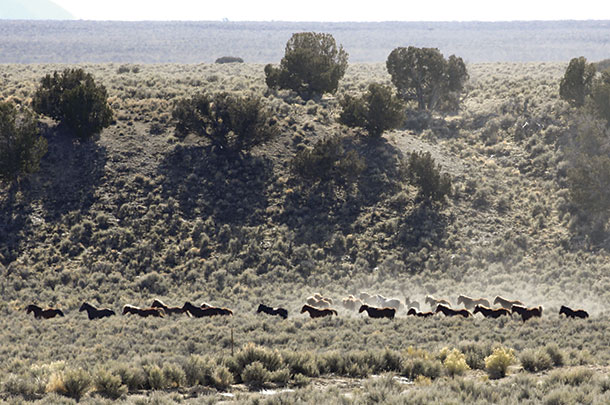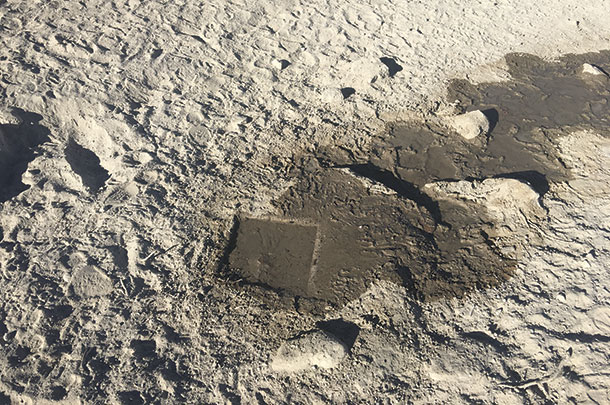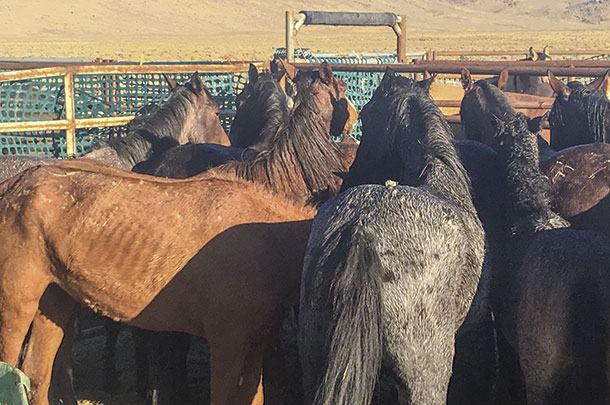These horse herds double in size every four or five years at a growth rate of approximately 20 percent a year and have reached a capacity that far succeeds what the 1971 Wild Free-Roaming Horses and Burros Act and the Bureau of Land Management (BLM) dubs the appropriate management level (AML) – the population of horses for a thriving, natural ecological balance.
BLM compiled data in early 2017 that estimate the current population of horses exceeds AML by more than 47,000 head.

The 1971 Wild Free-Roaming Horses and Burros Act protects the wild horses from capture, branding, harassment or death but allowed the removal of older and unadoptable animals through unrestricted sale or euthanasia.
The unrestricted ability to sell the horses was taken away around 10 years ago when a congressional appropriations rider banning the sale or transfer of horses for commercial purposes was included. The BLM holding areas for the horses are at full capacity, and the adoption market has dwindled, according to experts.
Language supporting the unrestricted sale of wild horses was introduced in the fiscal 2018 budget in the U.S. House of Representatives bill, but no language currently exists in the Senate side of the bill.
The best action to take for the horses, long held up as the symbol of the American West, is a hot-button political issue on both sides of the aisle. While the answer differs from one organization to the next, everyone involved agrees, something must be done quickly.
‘A wreck from the beginning’
J.J. Goicoechea, a fourth-generation Nevada rancher and Eureka County commissioner, is a passionate educator when it comes to the horse herds.
“We have horses dying every day of thirst and starvation,” says Goicoechea. “Every day we wait, it’s more and more costly to gather the horses and reinvigorate the rangeland. It won’t be pretty, but if we wait another three or four years, we’ll be having the conversation about what happened to our sage grouse, our mule deer and our elk. The ecological damage is astronomical.”
 Goicoechea, who also serves as the Nevada state veterinarian, has advocated at the national level for what he calls a commonsense approach to a complex and layered issue.
Goicoechea, who also serves as the Nevada state veterinarian, has advocated at the national level for what he calls a commonsense approach to a complex and layered issue.
“It’s been a wreck from the beginning that you couldn’t sell or dispose of excess horses. The adoption market has collapsed on the wild horse, and no one will adopt or buy them. Public safety has become a major problem here,” he says. “I have a utilitarian view. I don’t want to see the animal wasted. If we must harvest them, they are a good protein source that someone could use, but I cannot in good faith euthanize them and put them in the ground.”
The BLM currently cares for around 46,000 horses in long-term holding at a cost of $50,000 per horse during their lifetime, which encompasses a large majority of the BLM’s budget.
‘Close to a tipping point’
Greg Deimel, Elko BLM district affairs officer, says the BLM would be gathering 4,000 horses in 2018 as a means to make a small dent in the population. The Elko gather, which took place in February 2018, was restricted to 1,500 horses. One thousand of the horses were sent to long-term holding while 250 stallions were released back into the wild along with 250 mares that received fertility shots.
“We are getting close to a tipping point,” Deimel says. “We have thousands of horses on the range over the AML. Something has to be done at some point to get things in balance. The gather is one tool we can use, but it boils down to Congress. They passed the Wild Horse and Burro Act. They need to help us, and they have promised to help us, but it costs a lot of money.”
Ben Noyes, BLM Ely district wild horse and burro specialist, says many of the horses have left the herd management areas to look for more resources, especially in states such as Nevada where moisture is precious.
“Since we haven’t been doing gathers to keep horses at the AML, we’ve watched our numbers spiral out of control,” he says. “We’re almost eight times over AML. We can’t keep stockpiling more horses from the range in holding pens. There isn’t an outlet.”
Ethan Lane, executive director of the National Cattlemen’s Beef Association Federal Lands and the Public Lands Council, says he is lobbying for Congress to lift the rider on horse sales and let the BLM carry out the law.
“This is an organized effort by well-funded groups to put animal ag out of business. We are asking Congress to remove the rider, which most people think is the law. It’s misinformation; the law is very clear. We’re asking them to enforce it.”
Lane called the situation “unsustainable” and says it will come down to a battle for public opinion.

“We are seeing massive declines in rangeland health and consequently, we are seeing starving and dying horses, especially in places like Nevada,” he says. “The animal rights activists say fertility control is the issue, but the PZP [porcine zona pellucida vaccine] efficacy rate is 18 percent and requires annual application and a booster. Good luck gathering a wild horse and darting it a second time. It’s not feasible to look at it across a large scale.”
‘A political nightmare’
Gillian Lyons, senior wildlife fertility control policy manager with the Humane Society of the United States, says the solution to what she called a “political nightmare” has to be multifaceted.
“We are 100 percent against the killing of wild horses and burros,” she says. “It just won’t work. The cycle of removing horses isn’t successful to keep it low. The horses who are left will still breed. We want healthy horses and healthy ranch lands, but we’re going to have to work together to find a viable solution.
We have to stop looking at this from a metapopulation issue instead of a micropopulation issue. If we look at managing wild horses appropriately, everything else falls into place.”
Goicoechea says every day Congress waits to take action is another day the horses are driving populations of wildlife closer to towns, something he takes seriously as a veterinarian.
“You will see things like Lyme disease coming closer to people,” says Goicoechea. “A lot of groups make this a cow-versus-horse issue, but if we remove all of the livestock, it won’t matter. Those horses will kill this native land my family has been on for four generations.”
Layne and Goicoechea both recommend ranchers arm themselves with education and encourage their lawmakers to speak up.
“When you look at a mare or a foal starving to death, it impacts you in a way that I can’t explain until you see it,” Goicoechea says. “Don’t put your head in the sand. This isn’t Flicka running through the pasture with her head held high. These horses are suffering, and every animal should be treated with dignity. This isn’t fair to them.” ![]()
PHOTO 1: Wild horses are released back onto the range in 2017. Photo provided by Kyle Hendrix/BLM.
PHOTO 2: A large group of horses heads toward the trap area on the BLM Nevada Triple B Complex gather on Feb. 2, 2018. Photo courtesy of the Nevada BLM.
PHOTO 3: A puddle is all that’s left of a water source developed nearly 100 years ago. Permitted livestock no longer use the area, since the source is all for horses and wildlife. Photo by J.J. Goicoechea.
PHOTO 4: The body condition of horses removed due to emergency water shortage shows their lack of feed. Photo by J.J. Goicoechea.
Amy Schutte is a freelance writer based in Idaho. Email Amy Schutte.







